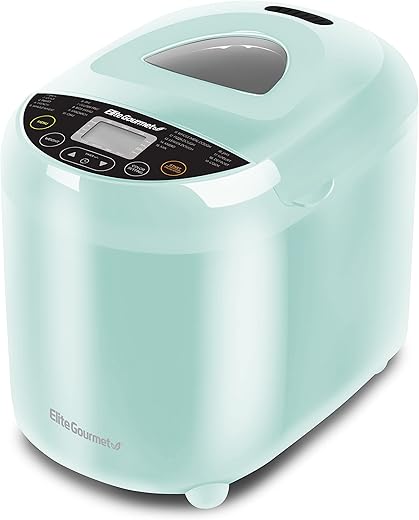Imagine waking up to the aroma of freshly baked bread wafting through your home. The allure of a warm, fluffy loaf that’s been perfectly baked to your personal preference is hard to resist. In the bustling world we live in, the traditional art of bread-making is often lost amidst our jam-packed schedules. That’s where a bread maker swoops in to save the day, combining convenience with the age-old charm of homemade bread. This ingenious kitchen appliance simplifies the bread-baking process, making it accessible to everyone, regardless of their baking skills or time constraints.
Bread makers are the unsung heroes in the quest for healthier eating habits. With this device at your disposal, you take full control over the ingredients, ensuring that your daily bread is free from the preservatives and additives found in store-bought varieties. It tackles the time-consuming kneading and rising steps with precision, all while you attend to other responsibilities. Plus, the versatility of a bread maker doesn’t stop at traditional wheat loaves; it invites you to explore a gamut of recipes including gluten-free, sourdough, and artisan bread, ensuring that even those with dietary restrictions can rejoice in the bread’s delightful crunch and pillowy interior. By solving the problems of time, skill level, and health concerns, the bread maker is not merely a machine—it’s a gateway to a more satisfying and wholesome way of living.
Elite Gourmet EBM8103M Programmable Bread Maker Machine 3 Loaf Sizes, 19 Menu Functions Gluten Free White Wheat Rye French and more, 2 Lbs, Mint
Function of Bread Maker
The bread maker is an innovative kitchen appliance specifically designed to automate the bread-making process. It combines the processes of mixing, kneading, rising, and baking, all within a single machine. The basic function involves the user adding ingredients to the bread pan, selecting the desired bread type and crust settings, and then allowing the machine to perform the bread-making cycle. High-end models may include additional functions such as different types of dough preparation, such as for pizza or pasta, and features like delay timers and keep-warm settings. Some bread makers even offer customizable programs, enabling users to fine-tune the entire baking process to suit specific recipes or personal preferences. A unique function of some bread makers is the ability to make gluten-free or whole grain bread, catering to health-conscious consumers.
Uses of Bread Maker
Bread makers are versatile in their uses, stretching beyond just baking standard white or wheat bread. They can be used to bake a wide variety of bread types including French, Italian, rye, and sourdough by adjusting the baking cycle accordingly. The appliance can also be tasked with making quick breads that do not require yeast, such as banana or cornbread. Many bread makers offer settings to produce dough for pizzas, croissants, rolls, and even pretzels. The jam setting is another feature, where users can make fresh, homemade fruit jams. Lastly, bread makers are ideal for people with dietary restrictions as they allow for complete control over the ingredients, catering for gluten-free or organic bread-making at home.
Design of Bread Maker
Bread makers typically have a compact and streamlined design intended to fit conveniently on a kitchen countertop. The outer shell is often constructed of a mix of stainless steel and durable plastic, designed to withstand high temperatures and provide a modern aesthetic appeal. Inside, the non-stick bread pan and kneading paddles are key components, usually removable for easy cleaning. The pan must fit securely within the appliance to prevent movement during the kneading phase. The lid of a bread maker often incorporates a viewing window that allows users to monitor the progress without lifting the lid and releasing heat. The control panel design varies from simple button interfaces to touch screens, with LCD displays showing timer and cycle information.
Build Quality of Bread Maker
The build quality of a bread maker determines its durability and lifespan. Reputable brands focus on using high-quality materials such as heavy-duty metals and BPA-free plastics to ensure robustness. The baking chamber should have excellent insulation to maintain consistent temperatures, ideally featuring double-layered walls. The bread pan and kneading paddles are typically coated with a non-stick material, which not only prevents the bread from sticking but also ensures longevity by reducing wear. High-quality gears and motors that drive the kneading mechanism are crucial, as they undergo significant stress during the bread-making process. A well-constructed bread maker operates quietly and efficiently, and higher-end models frequently provide replacement parts and comprehensive warranties.
Primary Features of Bread Maker
Key features of a bread maker include multiple pre-programmed settings that cater to a variety of bread types, crust colors, and loaf sizes. An express bake function is common for those who desire a quick turnaround. A signal for adding fruits or nuts is another feature found in most machines, which notifies the user at the correct time to mix in additional ingredients. The delay timer allows users to add ingredients and then program the bread maker to start at a later time, ensuring fresh bread is available exactly when needed. The kneading paddle comes in either a single or dual configuration, affecting the quality and texture of the bread. For the safety-conscious, automatic shut-off and a pause button are important features. Some bread makers also boast smart functionality, with connectivity to smartphones for even more control and customization.
Recommended Bread maker
“`html
Pros of Bread Maker
| Advantage | Impact on User Experience |
|---|---|
| Convenience | Users can bake bread easily with minimal manual intervention, saving time and effort. |
| Versatility | Allows users to create various types of bread and other recipes, enhancing culinary creativity. |
| Consistency | Users get consistent results every time, which is great for those who are inexperienced bakers. |
| Control over Ingredients | Users have full control over what goes into their bread, ideal for those with dietary restrictions. |
| Freshness | Bread is always fresh, which enhances taste and is healthier compared to store-bought alternatives. |
Cons of Bread Maker
| Disadvantage | Impact on User Experience |
|---|---|
| Counter Space | The machine can be bulky and take up significant kitchen space, which can be inconvenient in smaller kitchens. |
| Initial Cost | Some users might find the upfront investment high, especially if they do not plan to use it frequently. |
| Learning Curve | First-time users may require time to learn how to use the bread maker effectively, which can be discouraging. |
| Quality Variances | Cheap models may not produce the same quality of bread as higher-end models, affecting user satisfaction. |
| Customization Limitations | Some bread makers offer limited options for customizing the baking process, which might not meet the needs of all users. |
“`
This HTML code creates two separate tables that list the pros and cons of using a bread maker. Each table has a header for Advantage/Disadvantage and Impact on User Experience. Within each table, the rows are alternated with background colors to visually distinguish between the pros and cons sections. Each section dives straight into the points without any introduction or summary. The CSS provides a simple styling with solid black borders and padding for legibility.
Top 10 rated Bread maker
Consider Capacity Needs
When shopping for a bread maker, one of the key aspects to consider is the size of the machine. Think about your household’s bread consumption as it determines the capacity you require. Bread makers typically produce loaves that range from 1 pound to 2.5 pounds. Smaller households or those who consume bread less frequently may do well with a 1 to 1.5-pound loaf capacity. However, larger families or avid bread consumers may benefit from a machine with a 2 to 2.5-pound loaf capacity. Additionally, take note of the physical size of the bread maker if kitchen counter space is a concern.
Assessing Bread Maker Features
Modern bread makers come with a variety of features designed to enhance the baking experience. A crucial feature to look for is the number of baking cycles the machine offers. Basic cycles include white, whole wheat, French, and dough settings. More advanced machines may offer settings for gluten-free, artisanal, and sweet breads, as well as jam and yogurt making features. Additionally, consider models with delay timers that allow you to add ingredients and set the bread maker to start at a later time, so you can wake up to fresh bread. Machines with viewing windows let you monitor the progress of your bread without lifting the lid and potentially affecting the baking process.
Material and Build Quality
Durability is a significant factor to keep in mind when evaluating bread makers. A machine built with high-quality materials is likely to last longer and perform better. Look for bread makers with a sturdy, stainless steel or aluminum construction, as these materials are known for their longevity. Check the quality of the baking pan and kneading paddles—nonstick coatings can be convenient for cleaning and removing the bread after baking. However, ensure that the nonstick coating is of good quality so it does not peel off easily with use.
Ease of Use and Cleaning
For many users, a user-friendly interface is essential. Pick a bread maker with a clear, easy-to-read digital display and straightforward controls. Machines that come with preprogrammed settings can simplify the baking process for beginners. Likewise, consider how easy the bread maker is to clean. Machines with removable, dishwasher-safe pans and paddles offer convenience and save time, whereas machines with parts that must be washed by hand may require more effort post baking.
Customization Options
Those who like to experiment with different bread recipes should look for a machine with customizable settings. Advanced bread makers often allow you to alter the crust color from light to dark, and may have settings for kneading-only or rising-only functions if you prefer to handle certain steps manually. Additionally, some machines enable users to save their custom programs, which is ideal for those who have refined their recipes to perfection and want to replicate the results consistently.
Budget and Brand Reputation
Finding the right balance between cost and quality is critical. As with most appliances, higher price tags often come with more features and better build quality. However, it’s possible to find a bread maker that suits your needs without breaking the bank. Do some research on brands, read customer reviews, and compare warranties and after-sales service availability. Known brands with solid reputations in the kitchen appliance market are generally reliable and offer some peace of mind regarding customer service and product support.
Energy Efficiency and Noise Level
Lastly, consider the energy efficiency of the bread maker, as this will affect long-term costs. A well-insulated machine may use less energy to maintain the correct baking temperatures. Also, think about the noise level, particularly if you plan to use the delay timer to bake bread overnight. Some bread makers are quieter than others, which could be a crucial factor depending on when and how you plan to use your machine.
Best choice for Bread maker in 2024
Elite Gourmet EBM8103M Programmable Bread Maker Machine 3 Loaf Sizes, 19 Menu Functions Gluten Free White Wheat Rye French and more, 2 Lbs, Mint
Cuisinart Bread Maker Machine, Compact and Automatic, Customizable Settings, Up to 2lb Loaves, CBK-110P1, Silver,Black
KBS 17-in-1 Bread Maker-Dual Heaters, 710W Machine Stainless Steel with Gluten-Free, Dough Maker,Jam,Yogurt PROG, Auto Nut Dispenser,Ceramic Pan& Touch Panel, 3 Loaf Sizes 3 Crust Colors,Recipes
“`html
Define Your Needs
Consider your bread consumption: Think about the size of your family and how often you will be using the bread maker. This will guide you on the capacity of the machine you should be looking for.
Analyze features: Determine if you have any specific features in mind, such as gluten-free settings, delay timers, various loaf sizes, and crust color options. Prioritize what’s most important to you.
Research Brands and Models
Read product descriptions: On Amazon, each bread maker will have a detailed product description outlining its features, capability, and specifications. This will be your primary source of information for comparison.
Check brand reputation: Familiarize yourself with popular bread maker brands and read about their reputations for quality and customer service.
Read Customer Reviews and Ratings
Sort through reviews: Amazon’s customer review section provides invaluable insights. Look for consistent comments about durability, ease of use, and performance.
Analyze ratings: Consider products that have a high number of ratings combined with a 4-star or above average. This is a good indicator of customer satisfaction.
Consider Price and Warranty
Compare prices: Bread makers come in a range of prices. Filter your search on Amazon to stick to your budget while taking note of the aforementioned features.
Review warranty information: A good warranty can be very reassuring. Look for warranties that cover a significant period and check what aspects of the bread maker are included.
Look for Additional Resources
Seek out recipes: Some bread makers come with a recipe book. Check the Amazon description to see if this is included, or if the manufacturer provides a downloadable version.
Search for support: Availability of customer support and resources such as user manuals or FAQ sections are helpful for troubleshooting and tips on bread making.
Addressing Common Bread Maker Issues
Noise during operation: Some users might experience excessive noise. Check reviews specifically discussing the machine’s noise level to avoid models with known noise issues.
Bread not rising: Look for models with proven heating and kneading efficiency to ensure the dough rises properly. Customer reviews often highlight these performance aspects.
Uneven crusts: Ensuring even crusts is a common concern. Seek out models with uniform heating capabilities and those that come recommended for even baking.
Complicated interfaces: A user-friendly interface is crucial. Select models that have simple controls or touch screens with positive feedback regarding their ease of use.
Durability concerns: Some bread makers may have longevity issues. Research customer opinions about the product’s build quality to avoid models prone to breakdowns.
Cleaning difficulties: Bread makers should be easy to clean. Look for models with non-stick pans and removable parts to facilitate a quick and hassle-free cleanup.
“`
Cheapest alternatives for Bread maker
FAQ for Bread Maker Product Review
How does a bread maker work?
A bread maker is a kitchen appliance that automates the bread-making process. It typically combines ingredients, kneads the dough, allows it to rise, and then bakes it, all within the same machine. The user simply adds ingredients to the bread pan, selects the desired program, and the bread maker does the rest.
Can you make anything other than bread with a bread maker?
Yes, most bread makers come with multiple settings that allow you to make a variety of items such as pizza dough, cakes, jams, and even pasta dough. The specific functions will depend on the model of the bread maker.
Does the crust of the bread come out hard or soft from a bread maker?
Most bread makers offer crust control options so you can choose how dark or light you want your crust to be. This means you can have a softer or harder crust depending on your preference.
How long does it take to bake bread in a bread maker?
The duration it takes to bake bread in a bread maker can vary depending on the specific recipe and machine settings. It typically ranges from 2 to 4 hours, which includes the time needed for the dough to rise and the baking process itself.
Do I need special ingredients to bake bread in a bread maker?
No special ingredients are necessary; however, bread machine yeast is often recommended for better results. Otherwise, common bread-making ingredients like flour, water, salt, sugar, and fats are used. Some recipes may require additional ingredients like eggs, milk, or specific types of flour.
Can I use all-purpose flour instead of bread flour?
Yes, you can use all-purpose flour, but keep in mind that bread flour contains more protein, which helps develop gluten, resulting in better texture and rise. Your bread might be less chewy and not rise as much if you use all-purpose flour.
Is a bread maker cost-effective in the long run?
In most cases, making your own bread can be more cost-effective than buying artisan or preservative-free loaves from a store. Moreover, the price per loaf will typically decrease as you use your bread maker more frequently over time.
What size loaf can I make with a bread maker?
Bread makers usually have settings for different loaf sizes, often ranging from 1 pound to 2.5 pounds. Check the specifications of the model to see the sizes you can bake.
Is it safe to leave a bread maker unattended?
Yes, bread makers are designed to operate safely without supervision. However, it’s always a good practice to ensure the appliance is in good working order and there are no hazards nearby before leaving it to bake unattended.
How do I clean my bread maker?
Always unplug the bread maker and let it cool before cleaning. The bread pan and kneading paddles are usually removable and should be washed with warm, soapy water. The interior of the machine can be wiped down with a damp cloth. Avoid submerging the machine itself in water or placing it in the dishwasher unless the manufacturer specifies that it’s safe to do so.
In conclusion, after thoroughly reviewing the bread maker, it’s evident that this kitchen appliance is a valuable investment for anyone who loves the aroma and taste of freshly baked bread. Not only does it offer convenience by automating the bread-making process, but it also provides the flexibility to experiment with different types of bread, catering to all dietary needs and preferences.
The bread maker’s user-friendly interface makes it accessible to bakers of all skill levels, allowing you to effortlessly create a wide variety of breads with the push of a button. From gluten-free to whole-wheat options, you’re empowered to control the ingredients, ensuring healthier, preservative-free loaves for you and your family.
Additionally, the time-saving benefits cannot be overstated. With the delay-start and keep-warm functions, you can wake up to the smell of fresh bread or come home to a warm loaf ready for dinner. This not only cuts down on the time spent in the kitchen but also reduces the temptation to buy store-bought bread that often contains added sugars and chemicals.
Overall, the bread maker we’ve reviewed offers exceptional performance, unrivaled versatility, and the pure satisfaction of enjoying homemade bread. Whether you’re a busy professional, a health-conscious parent, or someone who takes pleasure in the art of baking, this bread maker is undoubtedly a worthwhile choice that promises to enhance your culinary experience.







